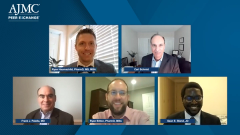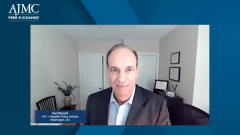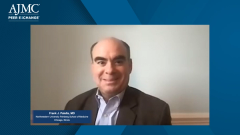
Improving Access and Uptake of HIV PrEP
Sean E. Bland, JD; Frank J. Palella, MD; and Carl Schmid explore organizational opportunities to improve access to HIV PrEP therapy and population health management strategies to improve PrEP uptake.
Episodes in this series

Ryan Haumschild, PharmD, MS, MBA: One of the biggest things I’ve taken away is never let a good crisis go to waste. Once this crisis occurs, how do we create change that’s not only temporary but improves the way we care for our patients moving forward specifically our patients getting access to PrEP [pre-exposure prophylaxis] therapy? You did a great job describing that and I’m curious, as we move forward and Sean, we’ve talked about some of these things that we’re able to do through telehealth. We’ve talked about some of these things we’re doing identifying patients, but Sean, what are some organizational opportunities to continue to improve this access for these eligible patients outside of telehealth and I know you spoke about them earlier but are there any additional opportunities we need to be exploring to keep improving this continuum of care?
Sean E. Bland, JD: Yes. I want to tie it into the last 2 questions because we always need to center and take a lens that’s focused on health equity when we’re thinking about the impact of COVID-19, as well as around the role of telehealth. If we’re not looking at the social inequities in our society, we’re not going to be doing the things that we’re doing so even with COVID-19, to keep the lens on how are the most vulnerable populations being impacted specifically around not only COVID-19 but around their ability to access PrEP. And we have seen some data from certain health centers that have shown that say black, gay, and bi [bisexual] men had more disruptions in terms of getting onto PrEP amid COVID-19. Similarly, when we think about telehealth and the opportunities there, we’re not thinking about the equitable access to things like smart phones, to Wi-Fi access, to mobile minutes, things like that. We’re not going to be able to get access telePrEP for folks. I just want to mention that. Additionally, there are so many opportunities for organizations to improve access under the recommendations so health care providers and organizations can monitor health plans to ensure their compliance with the requirements to cover both the medication and the services without cost sharing. It’s important that organizations do as much as they can to conduct outreach to health plans and also to the communities about PrEP and about the guidance and recommendations, and in particularly, see opportunities to adapt various models of service delivery that can improve access to care. Again, we mentioned telehealth and also home delivery model, but also same day PrEP initiation, express visits for PrEP, making sure that we’re utilizing not just doctors but nurses, pharmacy models, whatever it can take to make it as easy as possible for folks to both start and to stay on the PrEP, and to meet people where they are in communities. And again, there’s also a role to be played for health departments and the state and local insurance regulators to develop compliance tools to conduct audits to make sure that the compliance is happening and where there are some savings for health departments, for example, where they may end in the past have been using their funding for copay assistance with respect to PrEP maybe finding ways to redirect that assistance to expand education or navigation services for individuals.
Ryan Haumschild, PharmD, MS, MBA: It sounds like we’ve done some good work, but there’s still lots of work to get done, and Sean, I know you’ll be working through that kind of on a national level and that we need to continue to create these strategies and improving access and obviously monitoring care for the patients. And we think about monitoring care for a large patient population, right? Nowadays, you think of value-based care but you also think of population health, and we have so many population health management initiatives for endocrinology or diabetes, for lipidemia, for hypertension, but there’s a huge opportunity for PrEP that Sean discovered well, really part of a diversity equity and inclusion strategy, but also how do we improve the health of that population as a whole because we know PrEP is a part of that and we’ve established that. And I’m going to look to you, Carl. Population health is important, one of the things that people are focusing on across the board. What do you see as some potential strategies that we can utilize both as health care providers, payors broadly, to improve PrEP uptake?
Carl Schmid: Yes, well first of all, I want to emphasize some of the things that Sean said because it’s really important to get over the stigma, the racism, homophobia, the transphobia, as a society we have to address that. Also, we need to make sure that people have access to health care and health coverage, and payors for all of these services but additionally there’s a lot of technology that we can utilize these days, dating apps you could use to talk about PrEP, and advertis. And that’s another thing. There’s a lot of advertising these days for PrEP as well that it’s increasing awareness but it’s also reducing the stigma associated with HIV associated with PrEP. There’s one thing that I’m working on with some colleagues and that’s a bill in the Congress to make sure that all PrEP drugs as they come to the market by all payers have to be covered and have to have no cost sharing, and because there’s new drugs coming onto the market it’s going to take years and years to get through the process to get to the point where there’s that plans have to cover them and that there be 0 cost sharing. We would like to expedite that process and that’s a real game changer, but I’m sure my colleagues may have other ideas as well.
Ryan Haumschild, PharmD, MS, MBA: Frank, any thoughts from you in terms of from a provider standpoint, some strategies we can utilize? I don’t know if you feel like EMR [electronic medical record] in order sets and things like this or even prompts in the background that pick up on some of those determinants? Any thoughts that you would have on population health management strategies from a provider standpoint?
Frank J. Palella, MD: Yes. To echo some of the other comments, we do need to enhance effort. It’s directed at populations of greatest—who are often victimized by disparities and who are at greatest risk be it through electronic messaging, be it through internet based. Or be it through, and this in my experience has been one of the most effective means, through peer advocacy. Peer advocacy in person, virtual, or electronic is very powerful. And having the right message come from the right person makes a world of difference in terms of trying to achieve the desired goals. The systematization of this process, the ramping up so that you are not eligible or person in need of PrEP goes noncommunicated with or without communication is a goal. And again, we come back to these words of awareness, education, empowerment, these are 3 pillars of all of preventive and therapeutic health care. And they are particularly true with PrEP. Individuals must be aware of their own risk, aware of things they can do about it, have access to it, and feel comfortable sharing information about themselves. And I think there are now with all the electronic capabilities, there are a myriad of different pathways and incarnations that this could take. And we’re not even close to fully realizing them.
Ryan Haumschild, PharmD, MS, MBA: Itotally agree with you. And even identifying the patients that would have been eligible. And having a provider type monitoring of how well are we doing? Going through a screener that needs to be done for each one of these patients. How well are we focused on adherence and making sure that it’s not just prescribing it. But how’s that medication possession ratio working out for those patients? Is there any type of financial toxicity that we need to focus on even though we’ve done a lot of work? But if we have a nonpreferred agents, I think you’ve all hit on a lot of great ones. And social media, and advertising in the EMR, we create more of that holistic approach to monitoring and making sure that we’re following up on these initiatives and defining measures of success and not just kind of hoping that providers do the right thing.
Transcript Edited for Clarity
Newsletter
Stay ahead of policy, cost, and value—subscribe to AJMC for expert insights at the intersection of clinical care and health economics.








































